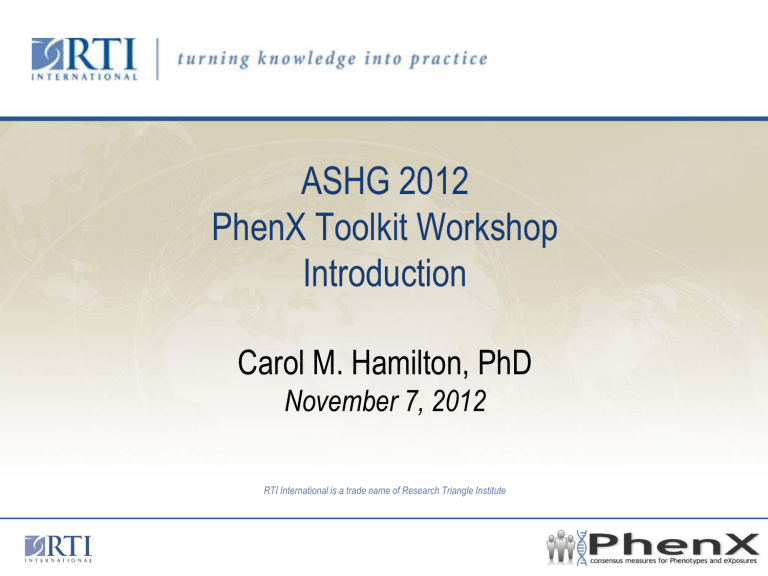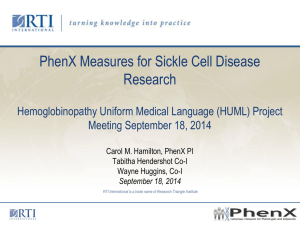Hamilton, C. M.

ASHG 2012
PhenX Toolkit Workshop
Introduction
Carol M. Hamilton, PhD
November 7, 2012
RTI International is a trade name of Research Triangle Institute
PhenX: consensus measures for
Phenotypes and eXposures
• PhenX is funded by the National Institute of Human Genomics
(NHGRI), Project Scientist, Dr. Erin Ramos
• NHGRI recognized that including standard measures in genomewide association studies (GWAS) would have significant impact on biomedical research and released an RFA
• In September 2007, RTI International was awarded this project to select and define high priority measures for GWAS
Standard Measures Needed
• Multi-IC Symposia on Applying Genomics Technologies to Population Studies
(2006)
–
Recommendations:
•
Limited subsets of phenotypic and exposure data that are amenable to common definition and standardized collection in GWAS should be identified in near future
• Better methods for phenotyping (rigorous, standardized, inexpensive, non-invasive, limited burden, appropriate for asymptomatic individuals) are needed, particularly for phenotypes relevant to a wide variety of diseases and disabilities
• Frontiers in Population Genomics (2007)
– Recommendations:
• Identify a subgroup of phenotypes and exposures with strong genetic associations for standardization and addition to GWAS
•
Support the review of phenotype and exposure data deposited in dbGaP to identify the most common measures and those that can be used in multiple studies.
3
Why Use Standard Measures?
• Study findings require validation
• Initial findings need to be replicated, standard measures aid comparisons
• Increased sample size provides greater statistical power
• For GWAS, to identify moderate associations and more complex interactions
• For other types of studies, increases statistical confidence in results
• Cross-study analyses increase the impact of individual studies
• Many diseases and conditions share common risk factors
• Use of standard (common) measures facilitates cross-study analyses
4
PhenX Approach
• The approach was to select 15 high-priority measures for each of 21 research domains
– Domains were selected by the PhenX Steering Committee
– Measures and protocols were chosen by Working Groups which are assembled for each domain
– Scientific community had the opportunity to review and comment on initial set of up to 25 measures for each domain
• Measures are made available to the research community via the
PhenX Toolkit
• The PhenX Toolkit facilitates broad use of standard measures by the research community, and promotes collaboration
• The PhenX Toolkit is available for use at no cost
5
PhenX - Building Consensus
• PhenX Steering Committee (SC)
– Provides guidance to the project
– Selects domains and define scope
• NIH Institutes and Centers (IC) Liaisons to SC
–
Provide expertise, outreach
• Expert Working Groups assembled for each domain
– Refine the scope
– Select specific measures and protocols
• Outreach to Scientific Community
– Obtain comments for consideration by the Working Groups
6
PhenX Definitions
• DOMAIN: Topical area with a unifying theme (organ system, complex disease, lifestyle factors, etc.)
Substance Use
• MEASURE: Broadly refers to a certain characteristic of, or relating to, a study subject that you are interested in capturing data on
Nicotine Dependence
• PROTOCOL: standard procedure recommended by a
Working Group for investigators to collect and record a PhenX measure
Fagerstrom Test
7
PhenX Definitions
• DOMAIN: Topical area with a unifying theme (organ system, complex disease, lifestyle factors, etc.)
Environmental Exposures
• MEASURE: Broadly refers to a certain characteristic of, or relating to, a study subject that you are interested in capturing data on
Air Contaminants in the Home Environment
• PROTOCOL: standard procedure recommended by a
Working Group for investigators to collect and record a
PhenX measure
Atmospheric and Environmental Research (AER) Inc.
8
PhenX Domains
• Alcohol, Tobacco, and Other
Substances
• Anthropometrics
• Cancer
• Cardiovascular
• Demographics
• Diabetes
• Environmental Exposures
• Gastrointestinal
• Infectious Diseases and
Immunity
• Neurology
• Nutrition and Dietary
Supplements
• Ocular
• Oral Health
• Physical Activity and Physical
Fitness
• Psychiatric
• Psychosocial
• Reproductive Health
• Respiratory
• Skin, Bone, Muscle, and Joint
• Social Environments
• Speech and Hearing
9
Criteria for Selecting PhenX Measures
• The measures should be:
• Clearly defined
• Well established
• Broadly applicable
• Validated
• Reproducible
• Specific
• Reliable
• Standard measurement protocols exist
10
Process for Selecting PhenX Measures
11
PhenX Toolkit
• Researchers will visit the Toolkit to:
– Add standard measures to ongoing studies
– Consider PhenX measures when planning new studies
– Obtain high quality measures outside of their area of expertise
– Review PhenX measures that relate to their primary research focus
• By selecting some of the PhenX measures:
– Ensure that their study will be compatible with others that also incorporate
PhenX measures
– Combine studies to increase statistical power and the ability to identify genes associated with complex diseases
– Potential to cumulatively combine with future studies
12
Facilitating Cross-Study Analysis
13
PhenX Toolkit Contents
• Recommended measures for each research domain
• Detailed protocols for collecting the measures
• Information about the measures
– Rationale for inclusion
–
References
– Supplemental Information
• User support
– Quick Start guide
–
Tutorial
– Glossary of terms
–
Frequently Asked Questions (FAQs)
– Feedback tool
14
Toolkit Features
• Search or Browse
– Browse by domain, collection or measure
– Search using “Smart Query Tool”
• Add measures to “My Toolkit”
– Recommends related measures
– Registration allows users to save and share multiple Toolkits
• Provides information about selected measures
– Reports, download, review, print or save
– Custom Data Collection Worksheets (DCW)
– Data Dictionaries (DD) support data submission to dbGaP
15
PhenX Smart Query Tool
• Search with Filters
– Filter search results using protocol characteristics (Data Collection Mode,
Lifestage, Time to Complete, and Language)
Smart Search
– Searches through measure names, aliases, and keywords; high specificity
Text Search
– Searches through full text of measures and protocols; high sensitivity
• Supplemental Information
– Searchable in the full-text search only
16
Visit PhenX:
ASHG booth #125
17
PhenX Collaborations
• National Center for Biotechnology Information (NCBI) database of
Genotypes and Phenotypes (dbGaP)
• Logical Observation Identifiers Names and Codes (LOINC)
• Cancer Data Standards Registry and Repository (caDSR) Common
Data Element (CDE) at cancer Biomedical Informatics Grid (caBIG)
• National Center for Biological Ontologies (NCBO) BioPortal
– NCBO mapped PhenX to BioPortal ontologies using Lexical OWL
Ontology Matcher (LOOM)
18
The database of Genotypes and Phenotypes
(dbGaP)
• NIH funded GWAS are required to deposit their data in dbGaP
• As a pilot, PhenX measures and variables were mapped to 16 studies in dbGaP
• Investigators will annotate PhenX measures when submitting data to dbGaP
• Investigators can search dbGaP and find studies that have variables that map to PhenX
19
PhenX in dbGaP Advanced Search
20
Search Results for “alcohol”(PhenX)
21
PhenX – adding SAA depth to the Toolkit
• National Institute on Drug Abuse (NIDA) sponsored a one year
Administrative Supplement to expand the Toolkit to support
Substance Abuse and Addiction (SAA) research
– Product is a “Core” collection of measures and six “Specialty” collections of measures
– Core measures would be suitable for all NIDA investigators,
Specialty measures would be included as appropriate
• NIDA now recommends use of PhenX measure in some funding announcements
22
Substance Abuse and Addiction (SAA)
Collections
• Core Collection, applicable to all SAA studies
– Core: Tier 1
– Core: Tier 2
• Specialty Collections (6)
– Assessment of Substance Use and Substance Use Disorders
– Substance-specific Intermediate Phenotypes
– Substance Use-related Neurobehavioral and Cognitive Risk Factors
– Substance Use-related Psychosocial Risk Factors
– Substance Use-related Community Factors
– Substance Use-related Co-morbidities and Health-related Outcomes
23
24
PhenX – fostering data sharing
• NHGRI and the Office of Behavioral and Social Sciences
Research (OBSSR) sponsored an Administrative Supplement to add PhenX measures to ongoing studies (for NIH funded projects)
– PhenX RISING, Real World Implementation, and SharING
– 7 ongoing studies, collaborating to expand their studies by adding PhenX measures
25
PI/Institution
Allison Aiello, Ph.D., University of Michigan
Study Name
Ecologic Stressors, Post-Traumatic
Stress Disorder, and Drug Use in
Detroit
Human Translational Applications
Core Robert Bilder, Ph.D., UCLA
Terry Jernigan, Ph.D., UCSD
Creating a Pediatric Imaging-
Genomics Data Resource
Catherine McCarty, Ph.D., Essentia Institute of
Rural Health
Dharambir Sanghera, Ph.D., University of
Oklahoma
Genome-Wide Study of Cataract and
Low HDL in Personalized Medicine
Research Project
Genome-Wide Association Scan to
Identify Risk Genes for Type 2
Diabetes in Asian Indians
# PhenX Measures
12
19
25
32
4
(bioassays)
Self-Regulation Failure: Identifying and Modifying a Risk Phenotype
37
Timothy Strauman, Ph.D., and Ahmad Hariri,
Ph.D. , Duke University
Yi Zeng, Ph.D.,
Duke University
Determinants of Healthy Longevity in
China
28
Toolkit Use Summary
( www.phenxtoolkit.org
October 2012)
Number of Visits: 344,381
Number of Unique Visits:
(by unique IP address)
84,326
Total Page Views: 1,509,329
Average Number Visits Per Day: 235
Total # of Countries with Toolkit Accesses: 149
Number of Registered Users: 935
27
Visits from the United States
28
Visits from Top Countries
Rank
1
7
8
9
10
11
2
3
4
5
6
12
13
14
15
Country
United States
United Kingdom (Great Britain)
Australia
Canada
India
China
Germany
Philippines
Netherlands
France
Italy
Malaysia
Brazil
Spain
Singapore
Number of Unique Visitors
33,553
1,059
817
686
612
608
4,699
3,477
2,855
2,428
1,301
603
590
516
471
29
Resources
• www.phenx.org
– Register to receive periodic updates via e-mail of the PhenX
Newsletter and notification of new surveys
• www.phenxtoolkit.org
– Additional measures and protocols will be included in the toolkit as they become available
• www.genome.gov/gwastudies/
– A catalog of published Genome-Wide Association Studies
(Hindorff et al. PNAS 2009)
30
Acknowledgements
• NHGRI
– Erin Ramos (Project Scientist)
– Heather Junkins (Project Analyst)
– Teri Manolio
• SC Members (12)
–
Jonathan Haines, Chair
– Bill Harlan, Vice-Chair
• WG Chairs / Members
• SSP (SAA Scientific Panel)
– Kenneth Sher, Chair
–
Kevin Conway, NIDA
• IC Liaisons
• dbGaP
–
Kim Tryka
– Mike Feolo
• LOINC
– Clem McDonald
– Daniel Vreeman
• eMERGE
– Rex Chisolm, Chris Chute, Dan Masys,
Cathy McCarthy
• NCBO BioPortal
•
Trish Whetzel, Mark Musen
• RTI Team
– Carol M. Hamilton (PI)
– Tabitha Hendershot (Co-Investigator)
– Joe Pratt (Project Manager)
– Dana Hancock
–
Jane Hammond
– Wayne Huggins
– Dean Jackman
– Debbie Maiese
– Destiney Nettles
–
Helen Pan
– Lisa Strader
– WG Managers
–
Toolkit team
– Communications team
–
Logistics team
31


![Service Coordination Toolkit Transition Planning Checklist [ DOC ]](http://s3.studylib.net/store/data/006933472_1-c85cecf2cfb8d9a7f8ddf8ceba8acaf8-300x300.png)



